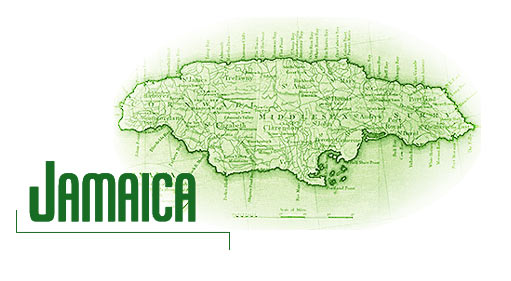
After
emancipation, labor opportunities and experiences changed for the better.
Before emancipation a slave was lucky if he lived nine years after being
captured. Some died from diseases, but many of them died from simple
overwork. Plantation owners found it cheaper to work slaves
to death and buy new ones than to give them the food and rest they needed
to survive and reproduce. Slave
life on the plantation was an absolute nightmare. Some slaves worked
up to twelve hours straight without a break, under a 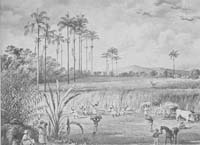 very
hot tropical sun. And the process of sugar making was not just hard
work but it was also dangerous. Because of the long hours worked some
slaves would fall asleep on the job. If that job was in the sugar mill
they could end up severely injured. A visitor to a plantation wrote
about how they handled serious injuries. The visitor was told by the
plantation owner that if a slave got his finger or arm caught in a mill
they would use a hatchet “that was always ready to sever the whole limb,
as the only means of saving the poor suffer’s
life.”
[1]
That is just a small portion of what slaves
had to go through. But better days were ahead for the slaves.
very
hot tropical sun. And the process of sugar making was not just hard
work but it was also dangerous. Because of the long hours worked some
slaves would fall asleep on the job. If that job was in the sugar mill
they could end up severely injured. A visitor to a plantation wrote
about how they handled serious injuries. The visitor was told by the
plantation owner that if a slave got his finger or arm caught in a mill
they would use a hatchet “that was always ready to sever the whole limb,
as the only means of saving the poor suffer’s
life.”
[1]
That is just a small portion of what slaves
had to go through. But better days were ahead for the slaves.
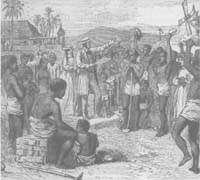 The
Emancipation Proclamation was read on August 1, 1834. There was plenty of singing, dancing,
and drumming to be seen and heard on that magical day. Many people celebrated
and the children added shouts “that seemed to rend the air.”
[2]
The Act of Emancipation “mandated in the first
instance large numbers of individuals were no longer slaves but neither
were they free citizens.”
[3]
Now there was a new hurdle, apprenticeship.
It was a turn from slave labor into a more acceptable, though still
mandatory form of labor, which would last four years.
The
Emancipation Proclamation was read on August 1, 1834. There was plenty of singing, dancing,
and drumming to be seen and heard on that magical day. Many people celebrated
and the children added shouts “that seemed to rend the air.”
[2]
The Act of Emancipation “mandated in the first
instance large numbers of individuals were no longer slaves but neither
were they free citizens.”
[3]
Now there was a new hurdle, apprenticeship.
It was a turn from slave labor into a more acceptable, though still
mandatory form of labor, which would last four years.
Apprenticeship
created several problems for the plantation owners. Slave owners were
used to working their slaves long hours. But
the days when owners could force slaves to work eighteen-hour days were
now no more. Apprentices could now only work forty hours
a week if they wished. Another problem was that many slaves used to
have to work the night shift. Emancipation put an end to that rule.
Blacks could now work four to five days a week and with the days they
had off, they could attend to their own gardens.
Of course, all too often the owners chose to ignore the new laws. The planters made no effort to change conditions
on the plantations. Getting new equipment and creating better working
conditions were out of the question. The plantation owners were expected
to supply medicine for the sick. That was not done. They were also expected
to supply better clothing and better food. Owners chose to ignore those
things as well. After emancipation the owners were given compensation
for their losses in human “property,” while ex-slaves received nothing.
Good
news came in 1837 when the apprenticeship was abolished. The planters
abused the system so much that it was terminated only after three years. More bad news came for the plantation owners.
The compensation that they received would not save most of them. Sugar prices continued to decline, even as production
went down because of the lack of workers. Instead of examining the situation
and admitting what was really wrong the planters decided to blame their
problems on the ex-slaves. The most often heard excuse was that blacks
were lazy and did not want to work anymore. The truth was that the ex-slaves
were finding new ways to make a living. They were tired of the working
conditions on the old plantations. They were sick of being treated with
cruelty. To many of them it was
time to move on. But some actually did stay on the plantations and tried
to make the best of it.
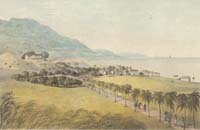 By
1860 half of the plantations in Jamaica had folded up. Many of the “plantations
were partly or wholly abandoned and the price of the property plummeted.”
The plantation owners only had themselves to blame. And with
the opening of the formerly protected British sugar market to free trade,
the few planters that survived “were forced to sell their crops on the
open market, often at a loss.”
[4]
By
1860 half of the plantations in Jamaica had folded up. Many of the “plantations
were partly or wholly abandoned and the price of the property plummeted.”
The plantation owners only had themselves to blame. And with
the opening of the formerly protected British sugar market to free trade,
the few planters that survived “were forced to sell their crops on the
open market, often at a loss.”
[4]
Former
slaves found new ways to make a living. Many of them became peasants
and formed villages and communities of their own. They began to grow
their own crops and sold them at the nearest markets. They grew ginger,
bananas, and sugar cane among many other crops. Of course the plantation
owners hated the fact that villages were springing up. These new villages
took away labor from them. The owners even found ways to get heavy taxes
placed on some of the most liked imported foods of the black man. And
as for American and British goods “the demand for linens, cottons, prints,
beaver hats, shoes, stockings, bonnets, and saddlery multiplied beyond belief.” But the heavy taxes placed on foreign goods
did not make the ex-slaves want to go back to the plantations.
[5]
At
first there were no schools or churches in the villages but that would
eventually change. After emancipation
“independent Negroes made the most of their income from growing provision
crops for sale in local markets.”
[6]
But other opportunities began popping up as
more and more villages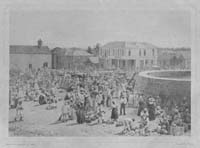 were being built. The villagers were not just building houses for themselves.
They were building for others too. And these new structures were not
little huts either. Some had several rooms so that everybody in the
household could have their own room. As for dirt floors, that became
a thing of the past for many households. Some had wooden floors made
from the native trees on the island. With their houses built, black
Jamaicans soon turned their attention to extending their villages by
helping missionaries construct churches and schools. This would be the
beginning of something special. Education was just around the corner
for many.
were being built. The villagers were not just building houses for themselves.
They were building for others too. And these new structures were not
little huts either. Some had several rooms so that everybody in the
household could have their own room. As for dirt floors, that became
a thing of the past for many households. Some had wooden floors made
from the native trees on the island. With their houses built, black
Jamaicans soon turned their attention to extending their villages by
helping missionaries construct churches and schools. This would be the
beginning of something special. Education was just around the corner
for many.
Education
played an enormous role in the upward movement of many free citizens. Many
young men and women attended the schools that sprang up 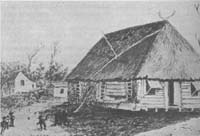 around
the island. Some
went on to become teachers and educate the next generation.
Others became ministers and preached in the local
churches. This was a step up
from the labor their parents performed.
Some were able to obtain jobs tending to business matters on
the island. But not everybody the island was able to attend schools
and obtain jobs such as teaching, and not everybody left the world of
hard manual labor. Job opportunities off the island became enticing.
Many still had to work jobs where
physical strength was needed.
around
the island. Some
went on to become teachers and educate the next generation.
Others became ministers and preached in the local
churches. This was a step up
from the labor their parents performed.
Some were able to obtain jobs tending to business matters on
the island. But not everybody the island was able to attend schools
and obtain jobs such as teaching, and not everybody left the world of
hard manual labor. Job opportunities off the island became enticing.
Many still had to work jobs where
physical strength was needed.
Panama was one such place where workers
were needed. A railway was needed there. But for the Jamaicans that
went, the great job opportunity turned into a nightmare. The Jamaicans were not the only ones who went
to Panama “to cut a canal across the Isthmus
in 1879.” Others such as the
Chinese and Europeans also went. Disease
was rampant and the deadly yellow fever was the worst of those illnesses. The Jamaicans and the West Indians “stood up
better to the fever, but a great many died, nevertheless, and within
nine years, after a shocking waste of life and money, the canal scheme
collapsed.” Many of those who
survived stayed in Panama. When the United States decided to build a canal in Panama in the early twentieth century many
Jamaicans again lent a hand in the construction of the canal.
[7]
Ex-slaves
and their children made many strides after emancipation. Life was not
easy for most of them but with ambition and pride came
success for many. Going from plantation work to becoming teachers and
ministers was not an easy or short journey. Freedom was something for
which they had been longing, and when it came they made the most of
it. All they needed was a chance and emancipation gave them that chance.
Many found that life could be something beautiful.
Works Cited
Craton, Michael and Walvin, James. A Jamaican Plantation: The History Of
Worthy Park 1670-1970. Toronto and Buffalo: University of Toronto Press, 1970.
Nugent, Maria, Lady. A Journal Of A Voyage To, And Residence
In, The Island Of Jamaica,
From 1801 To 1805, And The Subsequent Events In England from 1805 To
1811, By Maria, Lady Nugent. London: T. and W. Boone, 1839.
Papers Relative To The West Indies 1841. Part II Jamaica. London: W. Cloves and Sons. 1841.
Phillippo, James Mursell.
Jamaica: Its Past
And Present State. Philadelphia: J.M. Campbell And Co., New York: Saxton and Miles, 1843.
Sherlock, Philip and Bennett, Hazel.
The Story Of The Jamaican People. Kingston: Ian Randle Publishers, Princeton: Markus Wiener Publishers, 1998.
[1] Maria Nugent, A Journal Of A Voyage
To, And Residence In, The Island Of
Jamaica, From 1801 To 1805, And The Subsequent Events In England from
1805 To 1811, By Maria, Lady Nugent, (London, 1839,) 151.
[2] James M. Phillippo,
Jamaica: Its Past And Present State, (Philadelphia and New York, 1843,) 71.
[3]
Philip Sherlock and Hazel Bennett, The
Story Of The Jamaican People, (Kingston and Princeton, 1998,) 230.
[4] Sherlock and Bennett, 233.
[5]
Parliament, Papers Relative To The West Indies 1841. Part II Jamaica, (London, 1841,) 174.
[6] Michael Craton
and James Walvin, A
Jamaican Plantation: The History Of Worthy Park 1670-1970, (Toronto and Buffalo, 1970,) 215.
[7] Quotes from Clinton V. Black, History
of Jamaica, (London,
1958/1970,) 221.
